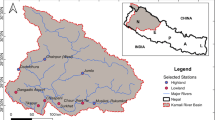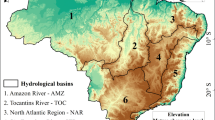Abstract
Limiting global warming to 1.5 °C and 2.0 °C above pre-industrial levels has been proposed as a way to reduce the impacts of climate change globally. Formulating reliable policies to adapt to these warming levels requires an understanding of the impacts at regional and national scales. The present study examines the potential impacts of the different global warming levels (1.5 °C and above) on climate extremes over Botswana, one of the most vulnerable countries to extreme climate events. Using a series of regional climate model simulations from the Coordinated Regional Climate Downscaling Experiment (CORDEX), we investigate the impacts of the warming on characteristics of the rainy season (onset, cessation, length, and number of wet days), extreme precipitation, and droughts. The simulations project a short length of the rainy season with a reduced number of wet days over Botswana at all the warming levels. They also indicate more frequent and intensified extreme precipitation, particularly in north-west Botswana. However, the additional rain water from the extreme rainfall may not offset the deficit in rainfall amount induced by the shorter rainy season with fewer wet days. Drought intensity and frequency are also projected to increase, but the magnitude of changes increases with higher warming levels. The policy implications of projected changes are discussed in relation to the possible impacts on society using agriculture and water availability as examples.





Similar content being viewed by others
References
Abiodun BJ, Adegoke J, Abatan AA, Ibe CA, Egbebiyi TS, Engelbrecht F, Pinto I (2017) Potential impacts of climate change on extreme precipitation over four African coastal cities. Clim Chang 143(3-4):399–413. https://doi.org/10.1007/s10584-017-2001-5
Abiodun BJ, Makhanya N, Petja B, Abatan AA, Oguntunde PG (2018) Future projection of droughts over major river basins in Southern Africa at specific global warming levels. Theor Appl Climatol. https://doi.org/10.1007/s00704-018-2693-0
Akinyemi FO (2017) Climate change and variability in semi-arid Palapye, Eastern Botswana: an assessment from smallholder farmers’ perspective. Weather Clim Soc 9(3):349–365. https://doi.org/10.1175/WCAS-D-16-0040
Akinyemi FO, Mashame G (2018) Analysis of land change in the dryland agricultural landscapes of eastern Botswana. Land Use Policy 76:798–811. https://doi.org/10.1016/j.landusepol.2018.03.010
Batisani N, Yarnal B (2010) Rainfall variability and trends in semi–arid Botswana: implications for climate change adaptation policy. Appl Geogr 30(4):483–489. https://doi.org/10.1016/j.apgeog.2009.10.007
Burke EJ, Perry RHJ, Brown SJ (2010) An extreme value analysis of UK drought and projections of change in the future. J Hydrol 388(1–2):131–143. https://doi.org/10.1016/j.jhydrol.2010.04.035
Byakatonda J, Parida BP, Kenabatho PK (2018a) Relating the dynamics of climatological and hydrological droughts in semiarid Botswana. Phys Chem Earth. https://doi.org/10.1016/j.pce.2018.02.004
Byakatonda J, Parida BP, Kenabatho PK, Moalafhi DB (2018b) Prediction of onset and cessation of austral summer rainfall and dry spell frequency analysis in semiarid Botswana. Theor Appl Climatol. https://doi.org/10.1007/s00704-017-2358-4
Dale VH, Hughes MJ, Hayes DJ (2016) Climate change and the future of natural disturbances in the Central Hardwood region. In: Greenberg CH, Collins BS (eds) Natural disturbances and historic range of variation. Springer, Switzerland, pp 355–369. https://doi.org/10.1007/978-3-319-21527-3_13
Department of Water Affairs (2017) Botswana water accounting report 2015–2016. Government of Botswana, Gaborone
Diallo I, Giorgi F, Deme A, Tall M, Mariotti L, Gaye AT 2016 Projected changes of summer monsoon extremes and hydroclimatic regimes over West Africa for the twenty-first century. Clim. Dyn. 47(12):3931–3954. https://doi.org/10.1007/s00382-016-3052-4
Diffenbaugh NS, Singh D, Mankin JS, Horton DE, Swain DL, Touma D, Charland A, Liu Y, Haugen M, Tsiang M, Rajaratnam B (2017) Quantifying the influence of global warming on unprecedented extreme climate events. PNAS 114(19):4881–4886. https://doi.org/10.1073/pnas.1618082114
Engelbrecht F, Adegoke J, Bopape MJ, Naidoo M, Garland R, Thatcher M, Gatebe C (2015) Projections of rapidly rising surface temperatures over Africa under low mitigation. Environ Res Lett 10:8. https://doi.org/10.1088/1748-9326/10/8/085004
FAO (2004) Drought impact mitigation and prevention in the Limpopo river basin: a situation analysis. http://www.sarpn.org/documents/d0001237/ Accessed 02 Jan 2017.
Giorgi F, Coppola E, Raffaele F, Diro GT, Fuentes-Franco R, Giuliani G, Mamgain A, Llopart MP, Mariotti L, Torma C (2014) Changes in extremes and hydroclimatic regimes in the CREMA ensemble projections. Clim. Change 125(1):39–51. https://doi.org/10.1007/s10584-014-1117-0
Hayes MJ, Svobola MD, Wilhite DA, Vanyarkho OV (1999) Monitoring the 1996 drought using the Standardized Precipitation Index. Bull Am Meteorol Soc 80(3):429–438
Karmalkar AV, Bradley RS (2017) Consequences of global warming of 1.5°C and 2°C for regional temperature and precipitation changes in the contiguous United States. PLoS ONE 12(1):e0168697. https://doi.org/10.1371/journal.pone.0168697
Kenabatho PK, Parida BP, Moalafhi DB (2012) The value of large-scale climate variables in climate change assessment: The case of Botswana’s rainfall. Phys Chem Earth 50–52:64–71. https://doi.org/10.1016/j.pce.2012.08.006
Kharin VV, Flato GM, Zhang X, Gillett NP, Zwiers F, Anderson KJ (2018) Risks from climate extremes change differently from 1.5°C to 2.0°C depending on rarity. Earth’s Future 6:704–715. https://doi.org/10.1002/2018EF000813
Klein Tank AMG, Zwiers FW, Zhang X (2009) Guidelines on analysis of extremes in a changing climate in support of informed decisions for adaptation. Climate data and monitoring WCDMP-No. 72, WMOTD No. 1500. World Meteorological Organization, Geneva, p 56
Klutse NAB, Ajayi VO, Gbobaniyi EO, Egbebiyi TS, Kouadio K, Nkrumah F, Quagraine KA, Olusegun C, Diasso U, Abiodun BJ, Lawal K, Nikulin G, Lennard C, Dosio A (2018) Potential impact of 1.5 °C and 2 °C global warming on consecutive dry and wet days over West Africa. Environ Res Lett 13:055013. https://doi.org/10.1088/1748-9326/aab37b
Lennard CJ, Nikulin G, Dosio A, Moufouma-Okia W (2018) On the need for regional climate information over Africa under varying levels of global warming. Environ Res Lett 13:060401. https://doi.org/10.1088/1748-9326/aab2b4
Masundire H, Morchain D, Raditloaneng N, Hegga S, Ziervogel G, Molefe C, Angula M, Omari K (2016) Vulnerability and risk assessment in Botswana’s Bobirwa sub-district: Fostering people-centred adaptation to climate change. ASSAR and CARIAA, Ottawa
Máure G, Pinto I, Ndebele-Murisa M, Muthige M, Lennard C, Nikulin G, Dosio A, Meque A (2018) The southern African climate under 1.5°C and 2°C of global warming as simulated by CORDEX regional climate models. Environ Res Lett 13:065002. https://doi.org/10.1088/1748-9326/aab190
Mba WP, Longandjo G-NT, Moufouma-Okia W, Bell J-P, James R, Vondou DA, Haensler A, Fotso-Nguemo TC, Guenang GM, Tchotchou ALD, Kamsu-Tamo PH, Takong RR, Nikulin G, Lennard CJ, Dosio A (2018) Consequences of 1.5 °C and 2 °C global warming levels for temperature and precipitation changes over Central Africa. Environ Res Lett 13:055011. https://doi.org/10.1088/1748-9326/aab048
McKee TB, Doesken NJ, Kleist J (1993) The relationship of drought frequency and duration to time scales. In: Proceedings of the 8th Conference on Applied Climatology, 17–22 January, 1993, Anaheim, CA, pp179–184.
Min S, Zhang X, Zwiers FW, Hegerl GC (2011) Human contribution to more-intense precipitation extremes. Nature 470:378–381. https://doi.org/10.1038/nature09763
Mugalavai EM, Kipkorir EC, Raes D, Rao M (2008) Analysis of rainfall onset, cessation and length of growing season for western Kenya. Agric Forest Meteorol 148:1123–1135
Nikulin G, Jones C, Giorgi F, Asrar G, Büchner M, Cerezo-Mota R, Christensen OB, Déqué M, Fernandez J, Hänsler A, van Meijgaard E, Samuelsson P, Sylla MB, Sushama L (2012) Precipitation climatology in an ensemble of CORDEX-Africa regional climate simulations. J Clim 25(18):6057–6078. https://doi.org/10.1175/JCLI-D-11-00375.1
Nikulin G, Lennard C, Dosio A, Kjellstroem E, Chen Y, Haensler A, Kupiainen M, Laprise R, Mariotti L, Maule CF, van Meijgaard E, Panitz HJ, Scinocca JF, Somot S (2018) The effects of 1.5 and 2 degrees of global warming on Africa in the CORDEX ensemble. Environ Res Lett 13:065003. https://doi.org/10.1088/1748-9326/aab1b1
Nkemelang T, New M, Zaroug MAH (2018) Temperature and precipitation extremes under current, 1.5°C and 2.0°C global warming above pre-industrial levels over Botswana, and implications for climate change vulnerability. Environ Res Lett. https://doi.org/10.1088/1748-9326/aac2f8
Omotosho JB, Balogun AA, Ogunjobi K (2000) Predicting monthly and seasonal rainfall, onset and cessation of the rainy season in West Africa using only surface data. Int J Climatol 20:865–880
Osima S, Indasi VS, Zaroug M, Endris HS, Gudoshava M, Misiani HO, Nimusiima A, Anyah RO, Otieno G, AOgwang B, Jain S, Kondowe AL, Mwangi E, Lennard C, Nikulin G, Dosio A (2018) Projected climate over the Greater Horn of Africa under 1.5 °C and 2 °C global warming. Environ Res Lett 13:065004. https://doi.org/10.1088/1748-9326/aaba1b
Pinto I, Lennard C, Tadross M, Hewitson B, Dosio A, Nikulin G, Panitz HJ, Shongwe ME (2016) Evaluation and projections of extreme precipitation over southern Africa from two CORDEX models. Clim Chang 135(3):655–668. https://doi.org/10.1007/s10584-015-1573-1
Pohl B, Macron C, Monerie P-A (2017) Fewer rainy days and more extreme rainfall by the end of the century in Southern Africa. Sci Rep 7:46466. https://doi.org/10.1038/srep46466
Reich PF, Numbem ST, Almaraz RA, Eswaran H (2001) Land resource stresses and desertification in Africa. In: Bridges EM, Hannam ID, Oldeman LR, Pening de Vries FWT, Scherr SJ, Sompatpanit S (eds) Responses to land degradation. Oxford Press, New Delhi
Riahi K, Rao S, Krey V, Cho C, Chirkov V, Fischer G, Kindermann G, Nakicenovic N, Rafaj P (2011) RCP 8.5 – A scenario of comparatively high greenhouse gas emissions. Clim Chang 109:33. https://doi.org/10.1007/s10584-011-0149-y
Schär C, Ban, N, Fischer EM, Rajczak J, Schmidli J, Frei C, Giorgi F, Karl TR, Kendon EJ, Klein Tank AMG, O’Gorman PA, Sillmann J, Zhang X, Zwiers FW (2016) Clim. Change 137(1-2): 201-216. https://doi.org/10.1007/s10584-016-1669-2
Shongwe ME, van Oldenborgh GJ, van den Hurk BJJM, van Aalst MK (2011) Projected changes in mean and extreme precipitation in Africa under global warming, Part II: East Africa. J Clim 25:3718–3733. https://doi.org/10.1175/2010JCLI2883.1
Shongwe ME, Lennard C, Liebmann B, Kalognomou E, Ntsangwane L, Pinto I (2014) An evaluation of CORDEX regional climate models in simulating precipitation over Southern Africa. Atmos Sci Lett 16:199–207. https://doi.org/10.1002/asl2.538
Statistics Botswana (2014) Population census atlas 2011: Botswana. Statistics Botswana, Gaborone
Stern RD, Dennett MD, Garbutt DJ (1981) The start of the rains in West Africa. Int J Climatol 1:59–68. https://doi.org/10.1002/joc.3370010107
van Wilgen NJ, Goodall V, Holness S, Chown SL, McGeoch MA (2015) Rising temperatures and changing rainfall patterns in South Africa’s national parks. Int J Climatol. https://doi.org/10.1002/joc.4377
Vicente-Serrano SM, Beguería S, López-Moreno JI, Angulo M, El Kenawy A (2010a) A new global 0.5° gridded dataset (1901–2006) of a multiscalar drought index: comparison with current drought index datasets based on the Palmer drought severity index. J Hydrometeorol 11(4):1033–1043. https://doi.org/10.1175/2010JHM1224.1
Vicente-Serrano SM, Begueria S, López-Moreno JI (2010b) A multiscalar drought index sensitive to global warming: The standardized precipitation evapotranspirationindex. J Clim 23:1696–1718. https://doi.org/10.1175/2009JCLI2909.1
Vicente-Serrano SM, Begueria S, Camarero JJ (2017) Drought severity in a changing climate. In: Eslamian S, Eslamian F (eds) Handbook of drought and water scarcity: Principles of drought and water scarcity. CRC Press, New York, pp 279–303
Zhang X, Zwiers F, Wan H (2013) Attributing intensification of precipitation extremes to human influence. Geophys Res Lett 40(19):5252–5257
Ziervogel G, New M, van Garderen EA, Midgley G, Taylor A, Hamann R, Stuart-Hill S, Myers J, Warburton M (2014) Climate change impacts and adaptation in South Africa. WIREs Clim Change 5:605–620. https://doi.org/10.1002/wcc.295
Author information
Authors and Affiliations
Contributions
Conceptualisation: B.J.A and F.O.A; analysis and visualisation: B.J.A.; writing—original draft preparation: F.O.A.; Writing—review and editing: B.J.A. and F.O.A.
Corresponding author
Ethics declarations
Conflict of interest
The authors declare that they have no conflict of interest.
Additional information
Publisher’s note
Springer Nature remains neutral with regard to jurisdictional claims in published maps and institutional affiliations.
Rights and permissions
About this article
Cite this article
Akinyemi, F.O., Abiodun, B.J. Potential impacts of global warming levels 1.5 °C and above on climate extremes in Botswana. Climatic Change 154, 387–400 (2019). https://doi.org/10.1007/s10584-019-02446-1
Received:
Accepted:
Published:
Issue Date:
DOI: https://doi.org/10.1007/s10584-019-02446-1




